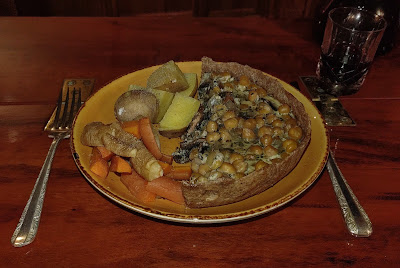This is one of my favourite quiches and is especially luxurious when made with cream. It is ideal for for entertaining, especially if you have baby new potatoes to go with it. In hot weather, when you don’t want your guests eating in a sweltering boat, it can be made in advance and eaten lukewarm.
I’m afraid that I don’t accept that a white sauce made with gram flour is an acceptable substitute for a sauce made with eggs. However, if you are well along the vegan spectrum, I suggest alternatives to cows’ milk, which is what I invariably use. You might want to use coconut milk - but I think that it might not complement the tarragon and green peppercorns.
Serves 2
Ingredients
1/2 cup chickpeas, soaked and cooked
1 recipe pastry
1 large onion, chopped
2 garlic cloves, diced
8 to 10 button mushrooms, sliced
1 tbsp olive oil
1 tbsp butter or extra olive oil
1 egg
1/3 cup (vegan) yoghurt OR cream
1/4 cup milk OR water
1/2 tsp tarragon
1 tsp crushed green peppercorns
salt
Method:
- Cook the chickpeas and set aside.
- Make the pastry and roll it out to fit a 230 mm (9 in) frying pan. Press to fit, cutting and pasting as necessary, to line the entire pan.
- Put the frying pan on a low heat over a flame tamer, and cook uncovered, for 10 to 15 minutes, until the pastry is crisp.
- Meanwhile, prepare the onion and garlic and fry in the oil and butter. If you don’t have any butter, use an extra tbsp of olive oil, but the butter makes this quiche richer.
- Slice the mushrooms and add to the pan. Cook without browning until the onion is thoroughly softened and the mushrooms have wilted.
- When the pastry is cooked, put the vegetables in the case, spreading them evenly over the base.
- Put the drained chickpeas on top, again spreading them out evenly.
- Gently beat the egg, yoghurt or cream and milk or water together. Mix in the tarragon, green peppercorns and salt. Pour this carefully into the frying pan, tilting it so that the custard is evenly distributed.
- Cover and cook over a low heat, until the custard has risen and is set – approximately 15 to 20 minutes.
Serve, if you can with new potatoes and a salad of mixed leaves. On a hot day, and in the unlikely event that youcan provide it, chilled white wine is delicious with this quiche.
Alternative cooking:
- If you prefer to cook the quiche in the oven, line a 200 mm (8 in) flan case with pastry and bake it in a pre-heated, Fairly Hot oven for 15 minutes. If possible, put a heavy baking sheet on the top shelf to heat up with the oven. This gives you a better chance of ending up with a crisp base.
- Follow stages 3 – 7. Reduce the oven setting to Moderate, and then put the quiche back in the oven for a further 30 minutes, until the filling is set. It should have risen to the top of the case and be a delicate golden colour.
Note:
- I have made this quiche with green peppercorns in brine, when I couldn’t find dried green peppercorns, but the result it disappointing compared with the dried ones.
- If you have access to fresh herbs, you might well prefer to use these. However, tarragon has its own quite distinct flavour, which I think goes well in this recipe.
You will find many more recipes




